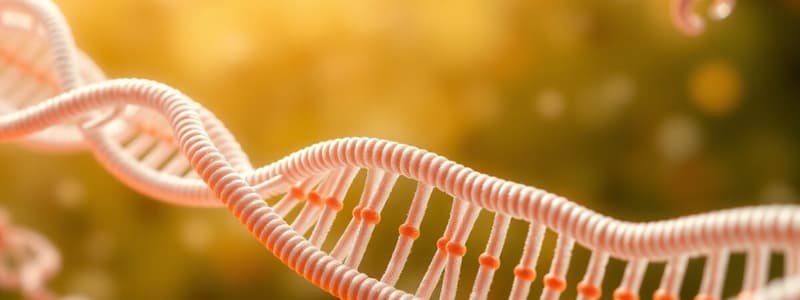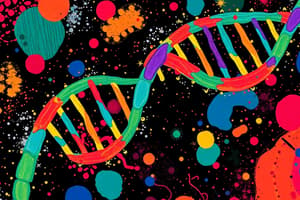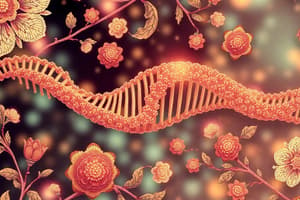Podcast
Questions and Answers
What is the condition of DNA required for transcription to occur?
What is the condition of DNA required for transcription to occur?
- It must be densely packed.
- It must be uncoiled from the beads. (correct)
- It must be in a circular form.
- It must be double-stranded and intact.
Chromatin that is in an uncoiled state during transcription is referred to as what?
Chromatin that is in an uncoiled state during transcription is referred to as what?
- Euchromatin (correct)
- Telomere chromatin
- Nucleosomal chromatin
- Heterochromatin
Which process involves the selective regulation of RNA molecules reaching DNA?
Which process involves the selective regulation of RNA molecules reaching DNA?
- Translation
- Transcription (correct)
- Post-transcriptional modification
- Replication
How are messenger RNAs formed in the cytoplasm?
How are messenger RNAs formed in the cytoplasm?
What term describes the selective process that controls the types of RNAs that are processed?
What term describes the selective process that controls the types of RNAs that are processed?
What role does crosstalk between tissues or cell types play in the process of differentiation?
What role does crosstalk between tissues or cell types play in the process of differentiation?
How many times is the initial size of the signal by the inducer estimated to be relative to the number of genes?
How many times is the initial size of the signal by the inducer estimated to be relative to the number of genes?
Which factor is crucial for the continuation of differentiation according to the provided content?
Which factor is crucial for the continuation of differentiation according to the provided content?
What might happen if crosstalk between cell types is disrupted?
What might happen if crosstalk between cell types is disrupted?
What is indicated by the reference to Figure 1.5 in relation to the content discussed?
What is indicated by the reference to Figure 1.5 in relation to the content discussed?
What is the role of the inducer in cellular interactions?
What is the role of the inducer in cellular interactions?
In the context of paracrine interactions, which of the following statements is accurate?
In the context of paracrine interactions, which of the following statements is accurate?
Which cell type consistently interacts with the inducer in a paracrine signaling context?
Which cell type consistently interacts with the inducer in a paracrine signaling context?
What is the significance of establishing communication lines in cellular interactions?
What is the significance of establishing communication lines in cellular interactions?
Which of the following best describes the relationship between the inducer and responder cells?
Which of the following best describes the relationship between the inducer and responder cells?
What is the primary role of transcription factors in gene expression?
What is the primary role of transcription factors in gene expression?
What structural feature is essential for the function of transcription factors?
What structural feature is essential for the function of transcription factors?
How do enhancers contribute to gene expression in specific tissues?
How do enhancers contribute to gene expression in specific tissues?
In which tissues are transcription factors mentioned to participate according to the content?
In which tissues are transcription factors mentioned to participate according to the content?
What additional function do transcription factors have aside from binding to their target DNA regions?
What additional function do transcription factors have aside from binding to their target DNA regions?
Which of the following statements about enhancer regions is FALSE?
Which of the following statements about enhancer regions is FALSE?
What does the term 'transactivating domain' refer to in transcription factors?
What does the term 'transactivating domain' refer to in transcription factors?
Which of the following best describes how transcription factors interact with RNA polymerase?
Which of the following best describes how transcription factors interact with RNA polymerase?
What is the primary role of nucleosomes in relation to DNA structure?
What is the primary role of nucleosomes in relation to DNA structure?
Which term describes the inactive state of chromatin characterized by its tightly packed structure?
Which term describes the inactive state of chromatin characterized by its tightly packed structure?
How can gene expression be regulated?
How can gene expression be regulated?
What does it mean for a single gene to give rise to many proteins?
What does it mean for a single gene to give rise to many proteins?
In what form does chromatin appear when it is in an active state?
In what form does chromatin appear when it is in an active state?
Which statement best describes the relationship between DNA and nucleosomes?
Which statement best describes the relationship between DNA and nucleosomes?
Why might certain genes not be transcribed?
Why might certain genes not be transcribed?
What do the 'beads' in 'beads on a string' refer to in the context of chromatin?
What do the 'beads' in 'beads on a string' refer to in the context of chromatin?
What is a primary interaction involved in the production of gut-derived organs?
What is a primary interaction involved in the production of gut-derived organs?
Which process can be employed to influence the activity of a signaling pathway?
Which process can be employed to influence the activity of a signaling pathway?
In the context of signaling pathways, what role does the hedgehog signaling pathway play?
In the context of signaling pathways, what role does the hedgehog signaling pathway play?
What is a consequence of disrupting epithelial-mesenchymal interactions?
What is a consequence of disrupting epithelial-mesenchymal interactions?
What can be inferred about the role of gut endoderm in organogenesis?
What can be inferred about the role of gut endoderm in organogenesis?
Flashcards
Transcription
Transcription
The process of making mRNA from DNA.
Euchromatin
Euchromatin
The state of DNA when it is uncoiled and accessible for transcription.
Beads
Beads
Small, dense structures that DNA wraps around to become more compact.
Uncoiling DNA
Uncoiling DNA
Signup and view all the flashcards
Cytoplasm
Cytoplasm
Signup and view all the flashcards
Enhancer
Enhancer
Signup and view all the flashcards
Transcription Factor
Transcription Factor
Signup and view all the flashcards
Promoter
Promoter
Signup and view all the flashcards
DNA-binding Domain
DNA-binding Domain
Signup and view all the flashcards
Transactivating Domain
Transactivating Domain
Signup and view all the flashcards
Gene Expression
Gene Expression
Signup and view all the flashcards
Inductive Event
Inductive Event
Signup and view all the flashcards
Initial Gene Expression Change
Initial Gene Expression Change
Signup and view all the flashcards
Gene expression regulation
Gene expression regulation
Signup and view all the flashcards
Nucleosomes
Nucleosomes
Signup and view all the flashcards
Crosstalk in Differentiation
Crosstalk in Differentiation
Signup and view all the flashcards
Heterochromatin
Heterochromatin
Signup and view all the flashcards
Differentiation Continuation
Differentiation Continuation
Signup and view all the flashcards
Feedback in Differentiation
Feedback in Differentiation
Signup and view all the flashcards
Translation
Translation
Signup and view all the flashcards
Multiple protein isoforms
Multiple protein isoforms
Signup and view all the flashcards
Differential gene expression
Differential gene expression
Signup and view all the flashcards
Paracrine Interaction
Paracrine Interaction
Signup and view all the flashcards
Inducer
Inducer
Signup and view all the flashcards
Responder
Responder
Signup and view all the flashcards
Signal
Signal
Signup and view all the flashcards
Cell Communication
Cell Communication
Signup and view all the flashcards
Epithelial-Mesenchymal Interactions
Epithelial-Mesenchymal Interactions
Signup and view all the flashcards
Hedgehog Signaling
Hedgehog Signaling
Signup and view all the flashcards
Inhibitor of a Pathway
Inhibitor of a Pathway
Signup and view all the flashcards
Direct Activation
Direct Activation
Signup and view all the flashcards
Indirect Activation
Indirect Activation
Signup and view all the flashcards
Study Notes
Introduction to Molecular Regulation and Signaling
- Molecular biology provides new methods for studying embryology and development.
- Sequencing the human genome and gene regulation studies have advanced embryological understanding.
- The human genome contains approximately 23,000 genes, which code for proteins that orchestrate development.
- Gene expression can be regulated at multiple levels: transcription, mRNA processing, translation, and protein modification.
- Chromatin, a complex of DNA and proteins (mostly histones), is the fundamental unit of chromatin.
- The basic unit of structure in chromatin is the nucleosome, composed of histone proteins and DNA.
- Heterochromatin is condensed DNA and is not transcribed, while euchromatin is uncondensed DNA that can be transcribed.
- Genes contain exons, which are translated into proteins, and introns, noncoding sequences.
- Regulatory elements including promoters, which bind RNA polymerase, and enhancers, which regulate promoter activity, are also present in genes.
- Transcription factors bind to promoters or enhancers to activate or repress gene expression.
- Enhancers are elements of DNA that control promoter efficiency and the rate of transcription.
- Enhancers can be located distantly from the promoter.
Other Regulators of Gene Expression
- The initial RNA transcript, also called nRNA or pre-mRNA, is longer than mature mRNA because it contains introns.
- Introns are removed through a process called splicing.
- Splicing isoforms are different proteins produced from the same gene.
- Post-translational modifications further modify the function of proteins.
- Spliceosomes are complexes of small nuclear RNAS (snRNAs) and proteins.
- Splicing isoforms allow the same gene to produce different proteins.
- Mutations in genes can alter post-translational modifications, thus affecting protein function.
Induction and Organ Formation
- Organs form through cell-to-cell interactions called induction.
- The inducer produces a signal, which activates a responder cell to change its developmental fate.
- Competence is the ability of a cell to respond to an inductive signal.
- Inductive interactions commonly occur between epithelial and mesenchymal cells.
- Paracrine signaling involves factors that diffuse between cells.
- Juxtacrine signaling involves cell-to-cell contact without diffusible factors.
- Gap junctions directly connect adjacent cells for signal transfer.
The Chromosome Theory of Inheritance
- Traits are determined by specific genes found on chromosomes.
- Humans have 23 pairs of homologous chromosomes forming a diploid number of 46.
- One chromosome from each pair is inherited from each parent.
- Meiosis reduces the chromosome number to haploid for gamete formation.
- Mitosis is the cell division process that produces genetically identical cells.
Meiosis
- Meiosis is a two-part cell division process that generates gametes (sperm and egg cells).
- Chromosomes replicate before meiosis I.
- Homologous chromosomes pair up during prophase I of meiosis I, exchanging segments in a process called crossover.
- Two rounds of cell division reduce the chromosome number from diploid to haploid.
Gametogenesis: Conversion of Germ Cells into Male and Female Gametes
- Development begins with fertilization, the union of a sperm and egg, to form a zygote.
- Primordial germ cells (PGCs) are formed in the epiblast and migrate to the gonads.
- PGCs in the developing gonads undergo mitosis until the fifth week.
- Gametes(sperm/egg cells) contain a haploid number of 23 chromosomes, making a diploid 46 total when combined.
- Gametogenesis includes meiosis to reduce chromosome number and cytodifferentiation to complete maturation.
- Male and female gametes each contribute 23 chromosomes to result in the complete diploid set of 46.
Clinical Correlates (Birth Defects and Spontaneous Abortions)
- Chromosomal abnormalities and mutations cause many birth defects.
- Numerical abnormalities include an extra/missing chromosomes, like trisomies (extra) and monosomies (missing).
- Structural abnormalities include deletions.
- About 10% of major birth defects arise from chromosomal abnormalities and 8% from gene mutations.
- The risk of these defects usually increases with maternal age.
Studying That Suits You
Use AI to generate personalized quizzes and flashcards to suit your learning preferences.
Related Documents
Description
Test your knowledge on the processes of DNA transcription, RNA formation, and the regulation of gene expression. This quiz covers key concepts such as chromatin structure, messenger RNA formation, and the importance of cellular interactions in differentiation. Dive into the details of how genes are selectively regulated and the implications of disrupted cellular communication.




